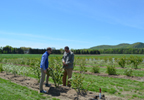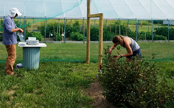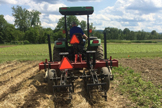
August 28, 2018; from CCE Essex News Bulletin:
The Reduced Tillage in Organic Systems Field Day event held on July 31st was a hit! We had 6 stations and about 70 attendees rotating among each, where a roller-crimper, a zone tiller, and weed management machinery were demonstrated among a variety of discussion topics related to incorporating reduced tillage management into crop production.
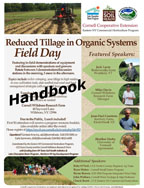
Check out the resource booklet that covers some of the topics and also incorporates related information here: Reduced Tillage Field Day Handbook (requires Acrobat Reader 9 or higher; alternate link:
https://rvpadmin.cce.cornell.edu/uploads/doc_699.pdf
This day was a collaboration of the Eastern NY Commercial Horticulture CCE team, Willsboro Research Farm, North Country Regional Ag CCE team, CCE Essex, Cornell Small Farms program, NYS IPM program, University of Vermont, and Champlain Basin Program. Expert guest speakers included Jean-Paul Cortens of Roxbury Farm and Jack Lazor of Butterworks Farm.
Thank you to the NY Soil Health program, Champlain Basin Program and the Northern New York Agricultural Development Program for your support. Great job, Amy Ivy, for pulling it all together!
Previously reported on this website:
The overall focus of the day (free to attend) on improving soil health was developed to meet grower requests. While the event is geared toward organic vegetable, row crop, and small grain growers, the practices discussed will also benefit conventional growers.
“Decreasing soil disturbance maintains diverse and active biological activity that is critical for well-functioning, healthy soil. Reducing tillage intensity and mechanical soil disturbance can improve soil health. Over time, this helps maintain or increase crop yields, while reducing production costs due to saved labor, equipment wear, and fuel,” notes organizer Amy Ivy, a vegetable specialist with Cornell Cooperative Extension, Clinton County.
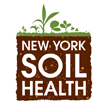 The field day topics include roller-crimping, zone tillage in high residue, in-row cultivation tools, stale seedbed and weed seed bank management strategies and grower experiences with reduced tillage on their farms.
The field day topics include roller-crimping, zone tillage in high residue, in-row cultivation tools, stale seedbed and weed seed bank management strategies and grower experiences with reduced tillage on their farms.
The field day speakers are Jean-Paul Courtens, Roxbury Farm, Kinderhook, NY; University of Vermont Agronomist Heather Darby; Cornell Willsboro Research Farm Manager Mike Davis; Jack Lazor, Butterwork Farm, Westfield, VT; Chuck Bornt, Cornell Cooperative Extension Eastern NY Commercial Horticulture Program; Bryan Brown and Ryan Maher, Cornell Small Farms Program; Kitty O’Neil, Cornell Cooperative Extension North Country Regional Ag Team; and Cornell University Weed Ecology and Management Professor John Wallace.
Participants at the day-long event will rotate between three demonstration and discussion stations in the morning and three in the afternoon. Lunch is included. The first 50 attendees will receive a program resource booklet.
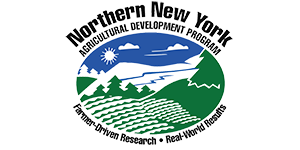 The Eastern NY Commercial Horticulture Program, Cornell Cooperative Extension of Essex County and the Cornell Willsboro Research Farm coordinated this field day with funding support from the New York State Soil Health Initiative, Lake Champlain Basin Program, and the farmer-driven Northern New York Agricultural Development Program.
The Eastern NY Commercial Horticulture Program, Cornell Cooperative Extension of Essex County and the Cornell Willsboro Research Farm coordinated this field day with funding support from the New York State Soil Health Initiative, Lake Champlain Basin Program, and the farmer-driven Northern New York Agricultural Development Program.
For more information, contact Amy Ivy, Cornell Cooperative Extension Clinton County, 518-561-7450, adi2@cornell.edu.
 Thank you, Mountain Lake PBS! Click on dated link to see the segment.
Thank you, Mountain Lake PBS! Click on dated link to see the segment.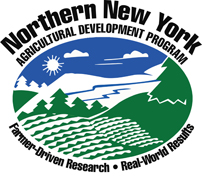 A grant from the farmer-driven Northern New York Agricultural Development Program (NNYADP) providing research and technical assistance to farms in the six northernmost counties of New York State provided the funds that created the Juneberry nursery at the Willsboro Research Farm. The farm is a Cornell University Agricultural Experiment Station.
A grant from the farmer-driven Northern New York Agricultural Development Program (NNYADP) providing research and technical assistance to farms in the six northernmost counties of New York State provided the funds that created the Juneberry nursery at the Willsboro Research Farm. The farm is a Cornell University Agricultural Experiment Station.